Have you ever wondered how many volcanoes exist on a single island? Well, get ready to be amazed as we take you on a journey to Camiguin Island in the Philippines—a destination like no other for volcano enthusiasts. Here, the volcanic landscape not only shapes the island’s topography but also intrigues scientists and beckons tourists from around the world. But the burning question remains: how many volcanoes are there in Camiguin?
Key Takeaways:
- Camiguin Island is home to seven volcanoes, making it an extraordinary destination for volcano enthusiasts.
- The volcanic landscape plays a significant role in shaping the island’s topography.
- Camiguin’s volcanoes attract scientists and tourists from all over the world.
- Stay tuned to discover more about the fascinating volcanoes of Camiguin Island!
Geological Birth Of Camiguin
Camiguin Island is steeped in a captivating geological history that has shaped its remarkable volcanic landscape. Through explosive eruptions and the flow of molten lava, this island emerged from the sea in a dramatic display of natural forces. With seven volcanoes dotting its surface, Camiguin boasts a diverse array of volcanic features that inspire awe and fascination.
Camiguin’s volcanic history is a testament to the raw power and beauty of nature. The island’s birth from the sea exemplifies the immense forces at work beneath the Earth’s surface. As these volcanoes formed, they sculpted the island’s topography, creating a landscape rich in both beauty and scientific significance.
The volcanic activity on Camiguin Island has given rise to a range of unique features. Majestic peaks, such as Mount Hibok-Hibok, offer breathtaking views of the surrounding area, while hot springs provide tranquil spots for relaxation and rejuvenation. One of the island’s most intriguing attractions is the sunken cemetery, where the remains of a volcanic eruption now rest beneath the sea.
Witnessing the volcanic landscape of Camiguin is a truly awe-inspiring experience. The island’s geological birth and the presence of multiple volcanoes have shaped a diverse and captivating landscape that continues to draw visitors from all over the world.
The volcanic history of Camiguin Island is a living testament to the Earth’s dynamic nature. It serves as a reminder of the ever-changing world we inhabit and the powerful forces that have shaped its landscapes throughout time.
Counting Camiguin’s Fire Mountains
Camiguin Island is truly a volcanic wonderland, boasting a total of seven volcanoes that have shaped its unique landscape. These majestic fire mountains contribute to the island’s charm and allure, attracting adventurers, nature enthusiasts, and scientists alike.
Among these seven volcanoes, four are classified as active: Hibok-Hibok, Vulkan Daan, Mount Vulcan, and Mount Mambajao. As these volcanic powerhouses simmer beneath the island’s surface, they serve as a reminder of the earth’s raw energy and the constant transformation of our planet.
The remaining three volcanoes on Camiguin Island are considered dormant: Mount Guinsiliban, Mount Butay, and Mount Uhay. While they may be temporarily inactive, they still contribute to the island’s extraordinary volcanic scape, leaving their mark on its geological heritage.
These seven volcanoes collectively create an awe-inspiring tapestry of diverse volcanic features, from lush green peaks to ancient craters and geothermal wonders. Their presence has profoundly influenced the island’s form and provided a backdrop that is both captivating and enchanting.
Camiguin’s Volcanoes
To provide a comprehensive overview of Camiguin’s volcanoes, here is a breakdown of their classifications:
| Volcano | Status |
|---|---|
| Hibok-Hibok | Active |
| Vulkan Daan | Active |
| Mount Vulcan | Active |
| Mount Mambajao | Active |
| Mount Guinsiliban | Dormant |
| Mount Butay | Dormant |
| Mount Uhay | Dormant |
Each volcano contributes to the island’s allure, offering a glimpse into the dynamic forces that have shaped Camiguin over millions of years. Exploring these fire mountains is not only an adventure but also an opportunity to witness the incredible beauty that arises from the earth’s fiery core.
Historical Eruptions Shaping The Island
The volcanoes of Camiguin have played a crucial role in shaping the island’s landscape throughout history. These volcanic eruptions have left their mark, creating a unique and captivating environment that attracts visitors from around the world. Let’s take a closer look at some of the most significant eruptions in Camiguin’s volcanic history.
The Powerful Eruption of Hibok-Hibok in 1951
One of the most notable volcanic eruptions in Camiguin’s history occurred in 1951 when Mount Hibok-Hibok erupted with immense power. The eruption lasted for several months and had a devastating impact on the surrounding area. Lava flows and pyroclastic flows demolished villages and agricultural fields, leaving a trail of destruction in their wake.
“The eruption of Hibok-Hibok in 1951 was a catastrophic event for the people of Camiguin. It not only caused extensive damage to the landscape but also resulted in the loss of many lives. The eruption served as a reminder of the volatile nature of volcanoes and their potential to unleash destruction.”
The Emergence of Mount Vulcan in 1871
In 1871, Camiguin witnessed the birth of a new volcano, Mount Vulcan. This eruption altered the island’s geography and added to its already diverse volcanic landscape. Mount Vulcan’s emergence created a distinctive cinder cone, which remains one of the island’s iconic landmarks.
Ancient Eruptions Leaving Fertile Soils
Beyond the more recent eruptions, Camiguin carries a geological history shaped by early volcanic activities. Over time, numerous eruptions have deposited volcanic ash and lava, enriching the soil and creating ideal conditions for agriculture. The fertile soils of Camiguin sustain its lush greenery and contribute to its natural beauty.
These historical eruptions serve as a reminder of the dynamic nature of volcanic activity and the lasting impact it can have on the environment. While they may pose risks and challenges, they also contribute to the island’s unique character, attracting curious adventurers and researchers alike.
| Eruption | Year | Impact |
|---|---|---|
| Hibok-Hibok | 1951 | Devastating eruption, destruction of villages and agricultural fields |
| Mount Vulcan | 1871 | Birth of a new volcano, formation of a cinder cone |
| Ancient Eruptions | Various | Deposited volcanic ash and lava, created fertile soils sustaining lush greenery |
The historical eruptions in Camiguin’s volcanic history continue to shape the island’s present landscape and contribute to its allure as a destination for nature enthusiasts, adventurers, and those seeking awe-inspiring natural wonders.
Profiles Of Prominent Peaks
Camiguin Island is blessed with majestic volcanoes that contribute to its unique volcanic landscape. Let’s explore two notable peaks that captivate both locals and visitors.
Mount Hibok-Hibok
| Elevation | Last Eruption | Activity Level |
|---|---|---|
| 1,332 meters | 1951 | Active |
Mount Hibok-Hibok is the most famous and active volcano on Camiguin Island. With an elevation of 1,332 meters, it proudly stands as a prominent landmark. Its last eruption occurred in 1951, leaving a lasting impact on the island’s landscape. Visitors can witness the majestic beauty of this volcano during guided hiking tours, where panoramic views and a sense of adventure await.
Mount Vulcan
| Elevation | Last Eruption | Activity Level |
|---|---|---|
| — meters | 1871 | Inactive |
Mount Vulcan, also known as the Old Volcano, presents a unique profile on Camiguin Island. It has a cinder cone shape and a lower height compared to Mount Hibok-Hibok, making it accessible for family-friendly hikes. While Mount Vulcan hasn’t been active since 1871, its historical significance and geological characteristics make it an intriguing destination for nature enthusiasts.
Monitoring the activity of these volcanoes is crucial to ensure the safety of both the island’s residents and visitors. Continuous volcanic monitoring conducted by experts allows for risk assessment and timely response to any potential volcanic unrest. This proactive approach helps maintain a balance between the fascination of exploring volcanic landscapes and the importance of safety.
The Seismic Activity: Monitoring And Risks
The volcanology and seismology experts in the Philippines closely monitor the seismic activity of Camiguin’s volcanoes. State-of-the-art technology, such as seismographs, gas sensors, and thermal cameras, is used to monitor volcanic unrest and predict eruptions.
Living near these volcanoes comes with risks, but the local community and government work together to ensure safety through evacuation plans, regular drills, and education about volcano risks.
“Volcanic activity can be unpredictable, which is why constant monitoring is crucial. Our advanced equipment helps us detect any changes in seismic activity or gas emissions, providing us with valuable insights into the potential danger levels of Camiguin’s volcanoes,” says Dr. Maria Santos, a volcanologist at the Institute of Volcanology and Seismology (PHIVOLCS).
Experts analyze data collected from monitoring stations strategically placed around the island. This data helps them assess the current state of volcanic activity and make informed decisions regarding safety measures.
The volcanic monitoring efforts also involve regular communication with local residents and businesses to keep them informed and prepared. Awareness campaigns and educational programs raise awareness about volcanic risks and the necessary precautions to take.
“It’s important for residents and tourists to understand the potential hazards associated with living near active volcanoes. By educating the community and promoting preparedness, we can reduce the risks and ensure everyone’s safety,” says Mayor Juanito Alcala, who leads the disaster management efforts in Camiguin.
Monitoring Techniques
Camiguin’s volcanic activity is closely monitored through various techniques:
- Seismographs: These instruments detect and record earthquakes originating from volcanic activity. By analyzing the seismic waves, experts can identify and locate volcanic tremors.
- Gas Sensors: Gas sensors measure the composition and concentration of volcanic gases, such as sulfur dioxide. Elevated gas emissions can indicate increasing volcanic activity.
- Thermal Cameras: These cameras detect changes in heat patterns, such as hotspots, on the surface of the volcanoes. Unusual temperature variations may signify volcanic unrest.
By combining data from these monitoring techniques, volcanologists can assess the level of volcanic activity and issue appropriate warnings if necessary, ensuring the safety of residents and visitors.
Risk Mitigation and Preparedness
Living near active volcanoes poses inherent risks, but the local community and government are proactive in minimizing these risks and prioritizing safety. Some of the key measures in place include:
- Evacuation Plans: The development of evacuation plans helps facilitate a swift and organized response in the event of an eruption or volcanic unrest. These plans identify evacuation routes, assembly areas, and shelters for affected residents.
- Regular Drills: Regular evacuation drills are conducted to ensure that residents are well-prepared and familiar with the evacuation procedures. These drills help build an efficient response system and increase the level of preparedness.
- Education and Awareness: Programs and campaigns educate both residents and tourists about volcano risks and safety measures. This knowledge empowers individuals to make informed decisions and respond appropriately during volcanic emergencies.
Ecological Impact And Biodiversity
The volcanic origins of Camiguin have had a profound impact on its ecosystems and biodiversity. The island’s fertile volcanic soil supports a diverse range of flora and fauna, with endemic species flourishing in the unique environment. The lush greenery and vibrant wildlife are a testament to the ecological abundance nurtured by the volcanic landscape.
“The volcanic landscape of Camiguin serves as a cradle of life, providing ideal conditions for various plant and animal species to thrive. It is truly a paradise for nature enthusiasts and researchers alike.” – Dr. Maria Santos, Ecologist
The volcanic soil of Camiguin contains rich minerals and nutrients that support the growth of a wide array of plant species. From dense forests to vibrant gardens, the island boasts a remarkable biodiversity. Visitors can explore lush tropical rainforests, marvel at colorful orchids, and encounter rare plants such as the Camiguin pitcher plant, known for its carnivorous nature.
The diverse ecosystem extends beyond flora to include a variety of fauna. Camiguin is home to numerous bird species, making it a haven for birdwatchers. The Philippine Tarsier, an iconic primate known for its large, expressive eyes, can also be found on the island. The volcanic landscape provides a natural habitat for these and many other unique creatures.
Recognizing the importance of preserving this ecological treasure, Camiguin has implemented various conservation efforts. Reforestation initiatives aim to restore and expand forested areas, ensuring the habitat for numerous species remains intact. Wildlife sanctuaries protect endangered animals and promote their conservation. Marine protected areas safeguard the rich underwater biodiversity found along Camiguin’s coastal regions.
One notable example is the Mantigue Island Nature Park, a marine sanctuary surrounding a volcanic island. Visitors can snorkel or dive to discover colorful corals, diverse fish species, and even sea turtles. The strict regulations and preservation efforts within the park contribute to the conservation of marine life and the ecological balance of the surrounding area.
By prioritizing the protection of the volcanic landscape and its biodiversity, Camiguin strives to maintain the delicate balance between human activities and the natural environment. Sustainable tourism practices and responsible behavior are encouraged to minimize the ecological impact and ensure the preservation of this unique paradise.
Camiguin’s Flora And Fauna Highlights
| Flora | Fauna |
|---|---|
| New Guinea Walking Stick Palm | Philippine Tarsier |
| Giant Staghorn Fern | Camiguin Pygmy Squirrel |
| Camiguin Pitcher Plant | Camiguin Island Honeybee |
| Fire Rafflesia | Philippine Cockatoo |
The table above showcases some of the fascinating flora and fauna that can be found on Camiguin Island. From unique plant species to endemic animals, the volcanic landscape provides a thriving habitat for these incredible organisms.
Tourism In The Shadow Of Giants
Camiguin’s volcanoes are major attractions for tourists. The island’s volcanic landscape provides a unique backdrop for adventure activities, such as trekking to the summit of Mount Hibok-Hibok, exploring the sunken cemetery, and relaxing in Ardent Hot Springs. Sustainable tourism practices are implemented to maintain the balance between tourism and natural preservation.
One of the most popular activities on Camiguin Island is trekking to the summit of Mount Hibok-Hibok. This active volcano, standing at an elevation of 1,332 meters, offers breathtaking views of the surrounding volcanic landscape. As visitors hike through the lush forests and rugged terrain, they are rewarded with panoramic vistas of the island’s other volcanic peaks and the sparkling blue waters that surround it.
“Trekking to the summit of Mount Hibok-Hibok was an incredible experience. The volcanic landscape and the vibrant flora and fauna made it a memorable adventure.” – Emily Johnson, Adventurer
Another unique attraction on Camiguin Island is the sunken cemetery. This cemetery was submerged in the 1871 eruption of Mount Vulcan, creating an eerie yet captivating underwater spectacle. Visitors can take a boat ride to the site and explore the rows of coral-encrusted tombstones, paying homage to the inhabitants of the past.
After a day of exploring volcanic wonders, visitors can relax in the therapeutic waters of Ardent Hot Springs. These natural hot springs are heated by the volcanic activity beneath the island and provide a rejuvenating experience. Surrounded by lush vegetation, visitors can soak in the warm, mineral-rich waters and unwind amidst the serene volcanic landscape.
Sustainable tourism practices are a priority on Camiguin Island to ensure the preservation of its unique volcanic landscape. Local tour operators and businesses promote responsible tourism by educating visitors about the importance of conserving the environment and minimizing their impact on the fragile ecosystems. The island’s residents are proud of their volcanic heritage and work together to protect and showcase its natural beauty.
Overall, tourism on Camiguin Island offers visitors a chance to immerse themselves in the shadow of giants. With its dramatic volcanic landscapes, thrilling adventure activities, and commitment to sustainable tourism, Camiguin provides a truly unforgettable experience that reflects the remarkable power and beauty of nature.
Balancing Tourism And Natural Preservation
Sustainable tourism practices are crucial for preserving the natural beauty of Camiguin Island, a volcanic paradise in the Philippines. Regulated tours and educational workshops play a vital role in raising awareness among both residents and visitors about the importance of protecting the unique volcanic landscape and its rich history.
By minimizing the impact of tourism activities, Camiguin aims to maintain the delicate balance between promoting tourism and preserving its natural wonders. It is essential to ensure that future generations can appreciate and explore the volcanic wonders while safeguarding the island’s ecological integrity.
“Preservation of the natural environment is our responsibility. Through sustainable tourism practices, we can protect the volcanic landscape of Camiguin and maintain its beauty for years to come.” – Jovelyn Cruz, Environmental Advocate.
Camiguin’s commitment to sustainable development encompasses various initiatives, including the establishment of protected areas, responsible waste management, and eco-friendly accommodations. Through these efforts, the island strives to create a harmonious synergy between tourism and the preservation of its unique geological heritage.
Regulated Tours And Workshops
Regulated tours are designed to provide visitors with an immersive experience while minimizing the ecological impact. Knowledgeable local guides lead visitors through carefully planned routes that showcase the volcanic wonders of Camiguin. As visitors explore the landscape, guides share insights on the island’s remarkable volcanic history, highlighting the significance of preserving its geological heritage.
Workshops and educational programs are organized to promote environmental awareness among residents and visitors. These programs focus on sustainable practices, such as responsible waste disposal, conservation of natural resources, and the importance of protecting the island’s fragile ecosystems. By actively engaging the community, Camiguin fosters a sense of stewardship and shared responsibility for preserving its volcanic landscape.
Achieving Environmental Harmony
Preserving Camiguin’s natural beauty requires collaboration between government entities, local communities, and tourists. The local government collaborates with environmental organizations, tourism associations, and local communities to develop and implement sustainable tourism practices.
Efforts are also made to promote eco-friendly accommodations and resorts that prioritize energy efficiency, waste reduction, and environmental conservation. These establishments serve as role models for sustainable practices in the tourism industry, inspiring others to follow suit.
The commitment to balancing tourism and natural preservation in Camiguin provides a model for other destinations around the world. By working together, we can ensure that future generations continue to enjoy and appreciate the awe-inspiring volcanic landscapes while safeguarding the planet’s natural wonders.
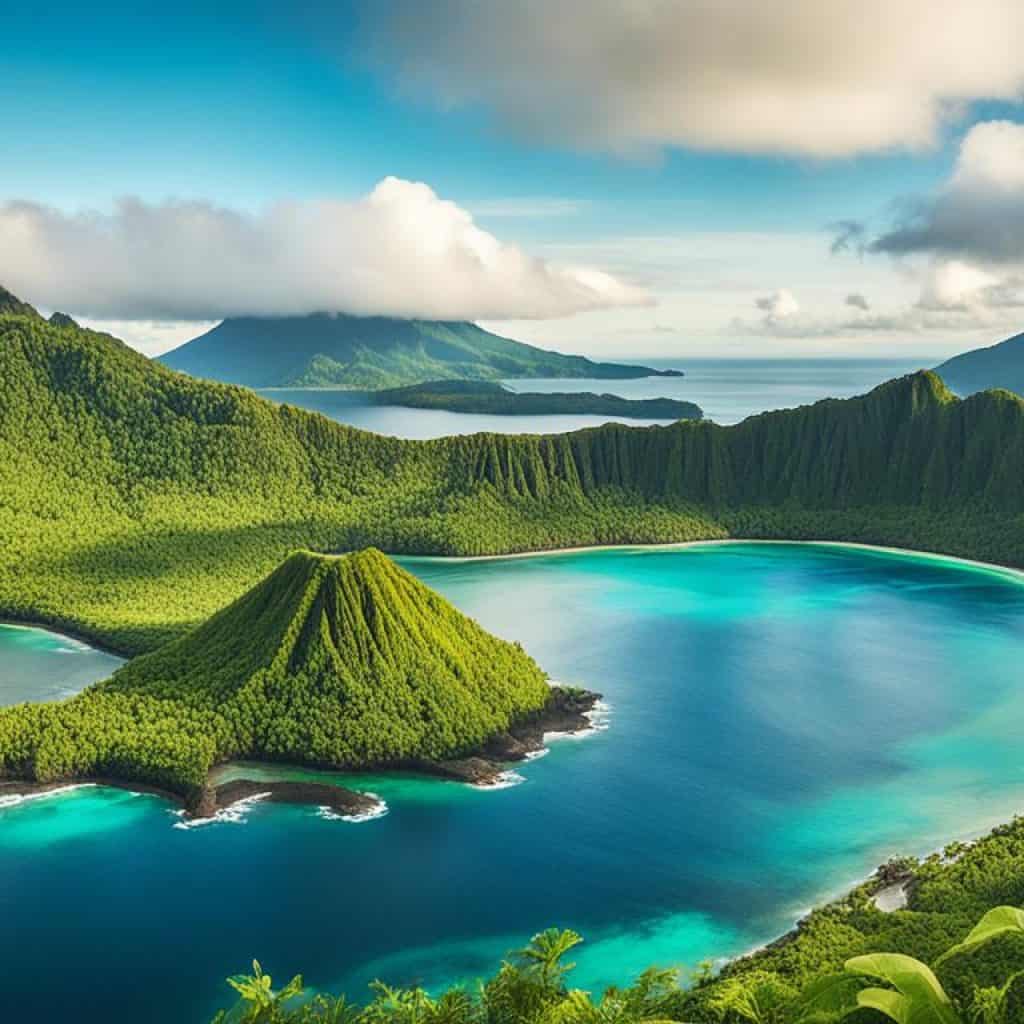
Exploring Camiguin’s Fiery Landscapes
Camiguin Island captivates visitors with its fiery landscapes and abundance of natural wonders. From the picturesque peaks of its volcanoes to the soothing hot springs and stunning waterfalls, this tropical paradise offers a diverse range of attractions that showcase the power of volcanic activity in shaping the island’s landscape.
The volcanic landscape of Camiguin Island is a sight to behold. The majestic volcanoes, with their towering peaks and rugged slopes, provide a stunning backdrop for exploration. Whether you’re an avid hiker seeking panoramic views or a nature lover looking to immerse yourself in the island’s unique ecosystem, Camiguin has something for everyone.
“The volcanic landscape of Camiguin Island is truly captivating. It’s like stepping into another world, where nature’s forces have sculpted a breathtaking paradise. The combination of lush greenery, azure waters, and volcanic features is a feast for the senses.”
– Claire Stevens, Travel Enthusiast
Camiguin’s Volcanic Attractions
One of the highlights of visiting Camiguin is exploring the volcanic attractions scattered across the island. Here are some must-visit sites:
- Mount Hibok-Hibok: This active volcano stands at an impressive elevation of 1,332 meters and offers exhilarating trekking opportunities. The challenging hike rewards climbers with panoramic views of the island and the surrounding seascape.
- Ardent Hot Springs: Nestled at the foot of Mount Hibok-Hibok, the Ardent Hot Springs provide a relaxing oasis for visitors. The geothermal waters, heated by the volcanic activity beneath the island, offer a rejuvenating experience amidst lush greenery.
- Tuasan Falls: Located in the heart of Camiguin’s volcanic landscape, Tuasan Falls is a stunning natural wonder. Surrounded by verdant forests, this majestic waterfall creates a picturesque scene that is perfect for swimming and picnicking.
These volcanic attractions are just a glimpse of the natural wonders that await visitors in Camiguin. The island’s fiery landscapes offer a truly unique and unforgettable travel experience that celebrates the raw power of nature.
Getting Around Camiguin’s Fiery Landscapes
To fully explore Camiguin’s volcanic attractions, it’s recommended to hire a tour guide or book a guided tour. Local guides provide valuable insights into the island’s geology, history, and cultural significance. They can also ensure your safety and help you make the most of your visit.
Camiguin’s volcanic landscape is best explored on foot, but there are also options for renting motorcycles or bicycles for a more adventurous experience. Take your time to marvel at the stunning views, soak in the hot springs, and immerse yourself in the natural beauty that Camiguin has to offer.
| Attraction | Description |
|---|---|
| Mount Hibok-Hibok | A thrilling trek to the summit of this active volcano rewards adventure enthusiasts with breathtaking views of the island. |
| Ardent Hot Springs | Relax and rejuvenate in the natural hot springs heated by volcanic activity, surrounded by lush greenery. |
| Tuasan Falls | Immerse yourself in the beauty of this majestic waterfall nestled amidst Camiguin’s volcanic landscape. |
Exploring Camiguin’s fiery landscapes is an awe-inspiring journey that will leave you with lasting memories. Whether you’re fascinated by volcanoes or simply seeking a unique travel experience, this volcanic island has it all. From challenging hikes to tranquil hot springs, Camiguin’s natural wonders are sure to captivate and inspire you.
The Cultural Significance Of Camiguin’s Volcanoes
The volcanoes of Camiguin Island hold immense cultural significance for the local communities. These majestic mountains form the foundation of the island’s rich cultural heritage, shaping the lives of its residents and inspiring various rituals, traditions, and beliefs.
The people of Camiguin have a deep respect for the power of nature, recognizing the volcanic landscape as an integral part of their identity. The volcanoes are seen as guardians, providing protection and prosperity to the island and its inhabitants.
One notable tradition centered around the volcanoes is the annual Lanzones Festival, where locals celebrate the bountiful harvest of lanzones, a tropical fruit grown abundantly in Camiguin. The festival showcases vibrant dances and colorful parades that pay homage to the volcanic landscape and its role in sustaining the island’s fertile soil.
Another cultural practice is the belief in the healing properties of the volcanic hot springs found across the island. These natural wonders are believed to possess therapeutic qualities, attracting visitors from far and wide seeking relaxation and rejuvenation.
“Our volcanoes are not just mountains; they are our protectors, our ancestors. They have shaped our lives and culture for generations, and we hold them in high regard.” – Local Resident
The cultural significance of Camiguin’s volcanoes can also be seen in the island’s art, literature, and music. Local artists draw inspiration from the volcanic landscape, creating stunning artworks that depict the raw beauty and power of the volcanoes. Traditional songs and stories passed down through generations often weave tales of volcanic eruptions and their impact on the island.
The volcanoes of Camiguin are not only awe-inspiring geological wonders but also pillars of cultural heritage. They serve as a constant reminder of the deep connection between people and nature, capturing the essence of Camiguin’s vibrant and diverse identity.
Rituals and Traditions Associated with Camiguin’s Volcanoes
| Ritual/Tradition | Description |
|---|---|
| Lanzones Festival | An annual celebration of the lanzones fruit harvest, paying tribute to the volcanic landscape’s role in sustaining fertile soil. |
| Healing Hot Springs | A belief in the therapeutic properties of volcanic hot springs, attracting visitors seeking relaxation and wellness. |
| Artistic Inspiration | Local artists draw inspiration from the volcanoes, creating artworks that showcase their beauty and power. |
| Oral Traditions | Songs, stories, and legends passed down through generations that depict the volcanic landscape’s impact on the island. |
The cultural significance of Camiguin’s volcanoes resonates deeply with the local communities, fostering a strong connection to the island’s volcanic heritage. Visitors to Camiguin are invited to explore not only its breathtaking landscapes but also the vibrant cultural tapestry woven around the majestic volcanoes.
Camiguin: An Island Of Adventure And Discovery
As you step onto the captivating island of Camiguin, you are greeted by an abundance of adventure and discovery. The volcanic landscape of this stunning destination sets the stage for exhilarating activities and unique experiences that will leave you in awe of the raw power of nature.
One of the major attractions in Camiguin is its volcanic features. Hiking enthusiasts can embark on thrilling treks to the summits of majestic volcanoes, such as Mount Hibok-Hibok, where breathtaking panoramic views await. The challenging trails and lush surroundings make these hikes truly unforgettable experiences.
Exploring the volcanic landscape further, you’ll encounter fascinating attractions that showcase the island’s volcanic heritage. Wander through the sunken cemetery, an intriguing site where tombstones rest eerily beneath the clear blue waters. The juxtaposition of the submerged tombstones with the vibrant marine life creates a hauntingly beautiful sight.
To truly immerse yourself in Camiguin’s unique ecosystem, make sure to visit Ardent Hot Springs. These therapeutic hot springs are a result of the island’s volcanic activity, providing a relaxing and rejuvenating experience. Soak your worries away in the warm waters and let the natural minerals soothe your body and soul.
Camiguin’s volcanoes not only offer thrilling adventures but also provide a fertile ground for biodiversity to flourish. The island’s volcanic soil supports a diverse range of flora and fauna, making it a haven for nature lovers. Take a guided tour or venture off the beaten path to witness the incredible array of plant and animal life found nowhere else in the world.
| Adventure Activities | Volcanic Attractions | Natural Wonders |
|---|---|---|
| Hiking to the summit of Mount Hibok-Hibok | Exploring the sunken cemetery | Marveling at stunning waterfalls |
| Snorkeling in the vibrant marine life | Soaking in Ardent Hot Springs | Admiring picturesque volcanic peaks |
| Zip-lining through lush forests | Discovering volcanic rock formations | Relaxing on pristine beaches |
Camiguin’s volcanic attractions and natural wonders create an environment that ignites the spirit of adventure and encourages exploration. Marvel at the power and beauty of the island’s volcanoes as you engage in thrilling activities, uncover hidden gems, and immerse yourself in the island’s unique ecosystem.
Camiguin is a true paradise for those seeking excitement, natural beauty, and a deeper connection with the forces that shape our world. Prepare to be mesmerized by the volcanic wonders that await you on this awe-inspiring island.
The Fiery Legacy Of Camiguin
Camiguin’s volcanic legacy showcases its awe-inspiring landscapes and rich geological history. The island’s fertile volcanic soil sustains a vibrant ecosystem, while its unique geological formations continue to captivate tourists and scientists alike.
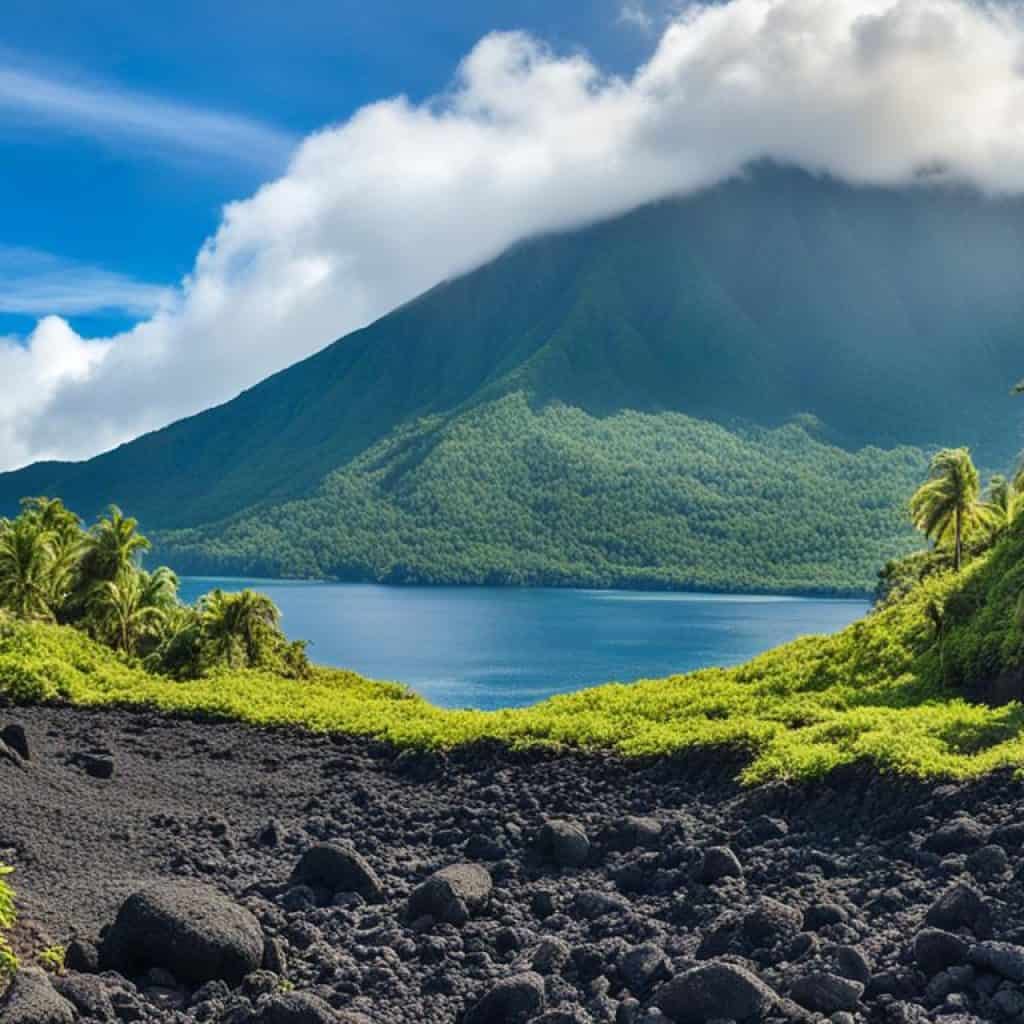
Camiguin’s volcanic history has left behind a remarkable legacy that shapes the island’s present and future. The dramatic volcanic landscape offers a visual feast of volcanic peaks, lush vegetation, and pristine coastline. The contrast between the fiery volcanic rock and the island’s lush greenery creates a stunning panorama.
The island’s volcanic soil is the foundation for a diverse range of flora and fauna. It provides the perfect environment for endemic species to thrive, making Camiguin a biodiversity hotspot. The volcanic influence on the island’s ecosystem is unmistakable.
Camiguin’s unique geological formations also attract geologists, volcanologists, and researchers from around the world. The island provides a living laboratory for studying volcanic phenomena, contributing to a better understanding of Earth’s geological processes.
The volcanic legacy of Camiguin shapes not only its physical landscape but also its cultural heritage. The island’s residents hold deep respect for the volcanoes that surround them, viewing them as powerful forces that have shaped their lives and traditions.
Volcanic Features of Camiguin
Camiguin’s volcanic landscape showcases a variety of geological features, each bearing witness to the island’s fiery past:
| Volcanic Feature | Description |
|---|---|
| Volcanic Peaks | The island is adorned with majestic volcanic peaks, including Mount Hibok-Hibok, Mount Vulcan, and others, offering breathtaking views and challenging climbs for adventurous hikers. |
| Hot Springs | Ardent Hot Springs and other geothermal sites provide a soothing escape, where visitors can relax and indulge in the healing properties of volcanic hot water. |
| Sunken Cemetery | An eerie reminder of past volcanic eruptions, the Sunken Cemetery now lies beneath the sea, creating a unique diving and snorkeling site that showcases the island’s volcanic history. |
Camiguin’s volcanic legacy is a testament to the transformative power of nature. From its breathtaking landscapes to its vibrant biodiversity, the island continues to inspire and invite exploration. The fiery legacy of Camiguin is a story written in rock and soil, an enduring reminder of the island’s volcanic past and a promise of its fiery future.
Conclusion
Camiguin Island is a testament to the fiery beauty and geological wonders that volcanoes produce. With its seven volcanoes and diverse volcanic landscape, Camiguin offers a truly unique travel experience. From thrilling adventure activities to breathtaking views, this volcanic island captivates visitors and showcases the remarkable power of nature.
Exploring Camiguin’s volcanic landscape is an opportunity to witness the raw forces that have shaped this captivating island. The presence of seven volcanoes highlights the island’s geological significance, attracting scientists and volcano enthusiasts from around the world. Whether hiking to the summit of Mount Hibok-Hibok or indulging in the therapeutic hot springs, every moment in Camiguin is an adventure.
With its rich volcanic history and ecological impact, Camiguin stands as a treasure trove of biodiversity and cultural heritage. The island’s conservation efforts and sustainable tourism practices ensure a balance between tourism and natural preservation. By experiencing the wonders of Camiguin’s volcanic landscape, visitors gain a deeper appreciation for the interconnectedness of geology, ecology, and human culture.
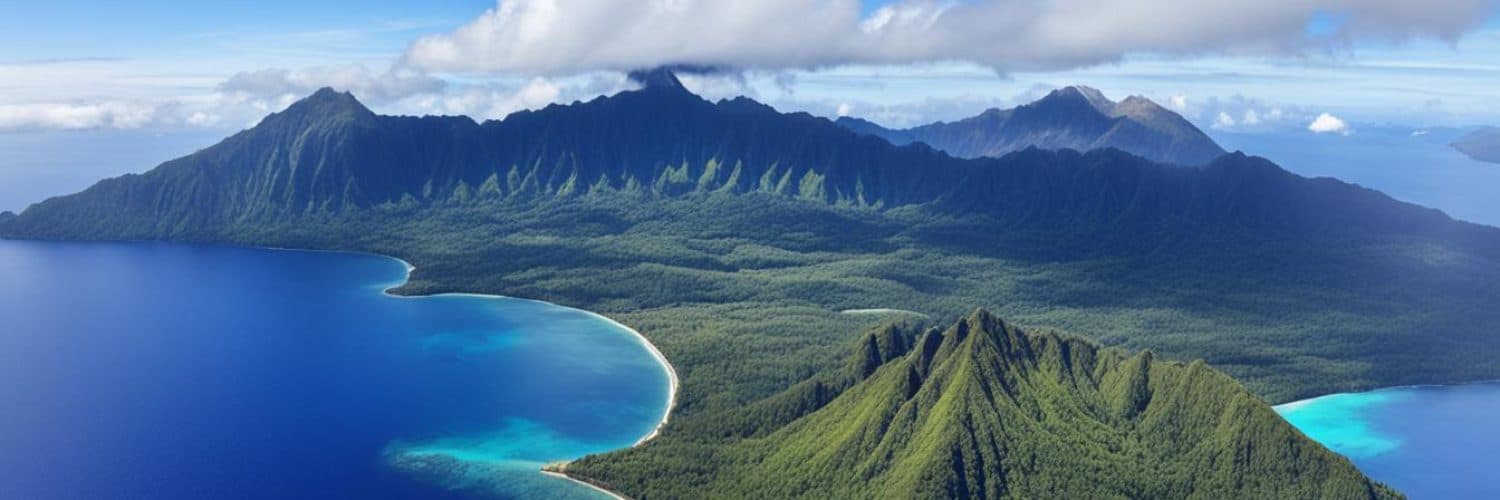
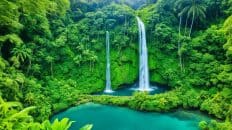
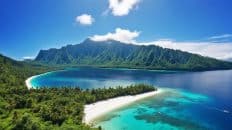















Add comment